Economics Report: The Future of Private Hire Cars in Singapore
VerifiedAdded on 2022/12/27
|16
|4242
|84
Report
AI Summary
This report examines the duopolistic competition between Grab and Gojek in Singapore's private hire car market. It analyzes Gojek's strategies, particularly dynamic pricing, in response to Grab's market dominance and uses the Cournot model to explore market equilibrium. The report discusses Grab's potential cost strategies, including first-mover advantage, limit pricing, and predatory pricing, and their impact on Gojek. It concludes that Gojek faces significant challenges due to Grab's economies of scale and potential for monopolistic practices, and recommends measures to prevent customer exploitation. The report also considers the implications of Gojek's potential exit from the market and the resulting market concentration. The report is an economic analysis of the transportation industry in Singapore.
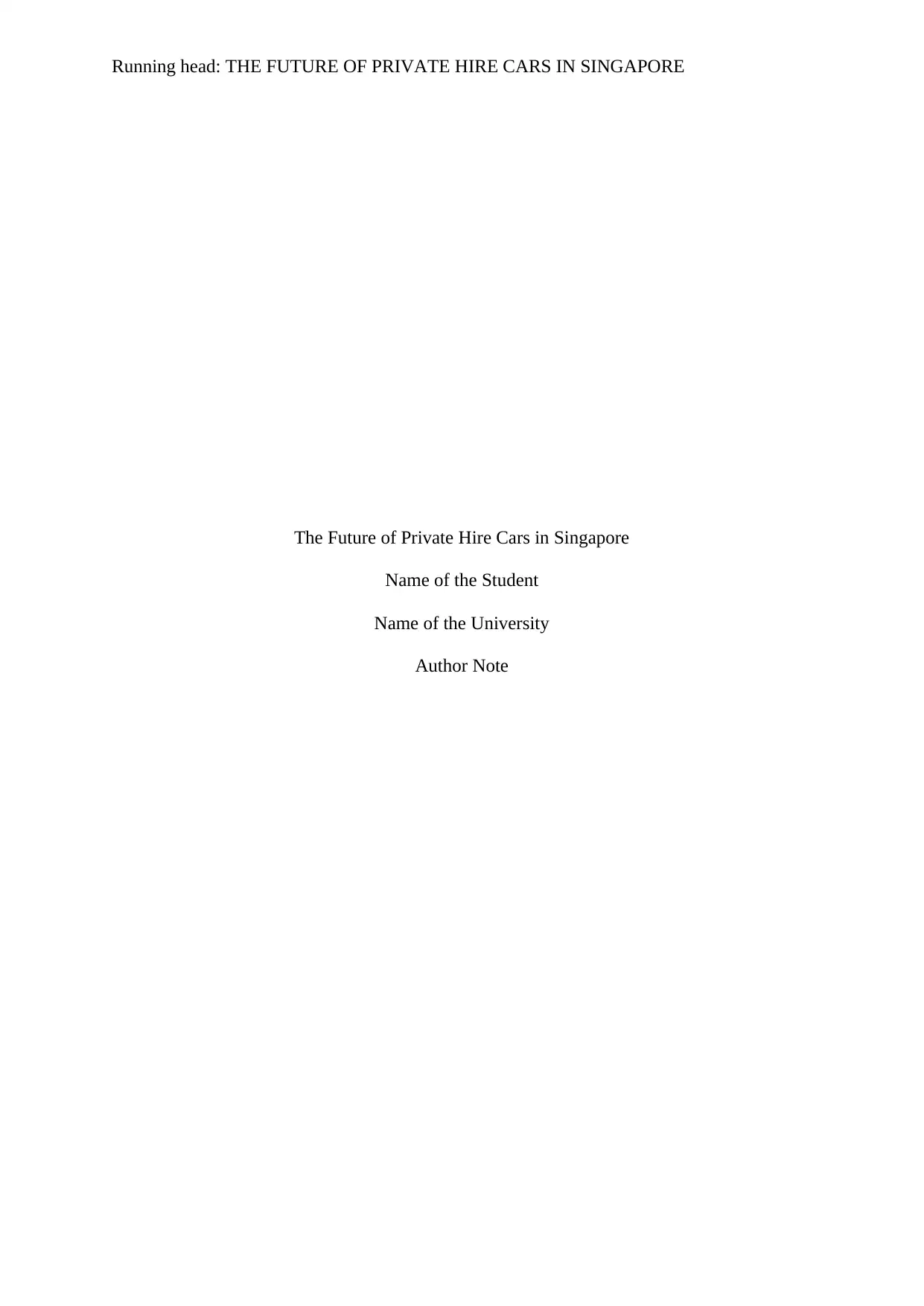
Running head: THE FUTURE OF PRIVATE HIRE CARS IN SINGAPORE
The Future of Private Hire Cars in Singapore
Name of the Student
Name of the University
Author Note
The Future of Private Hire Cars in Singapore
Name of the Student
Name of the University
Author Note
Paraphrase This Document
Need a fresh take? Get an instant paraphrase of this document with our AI Paraphraser
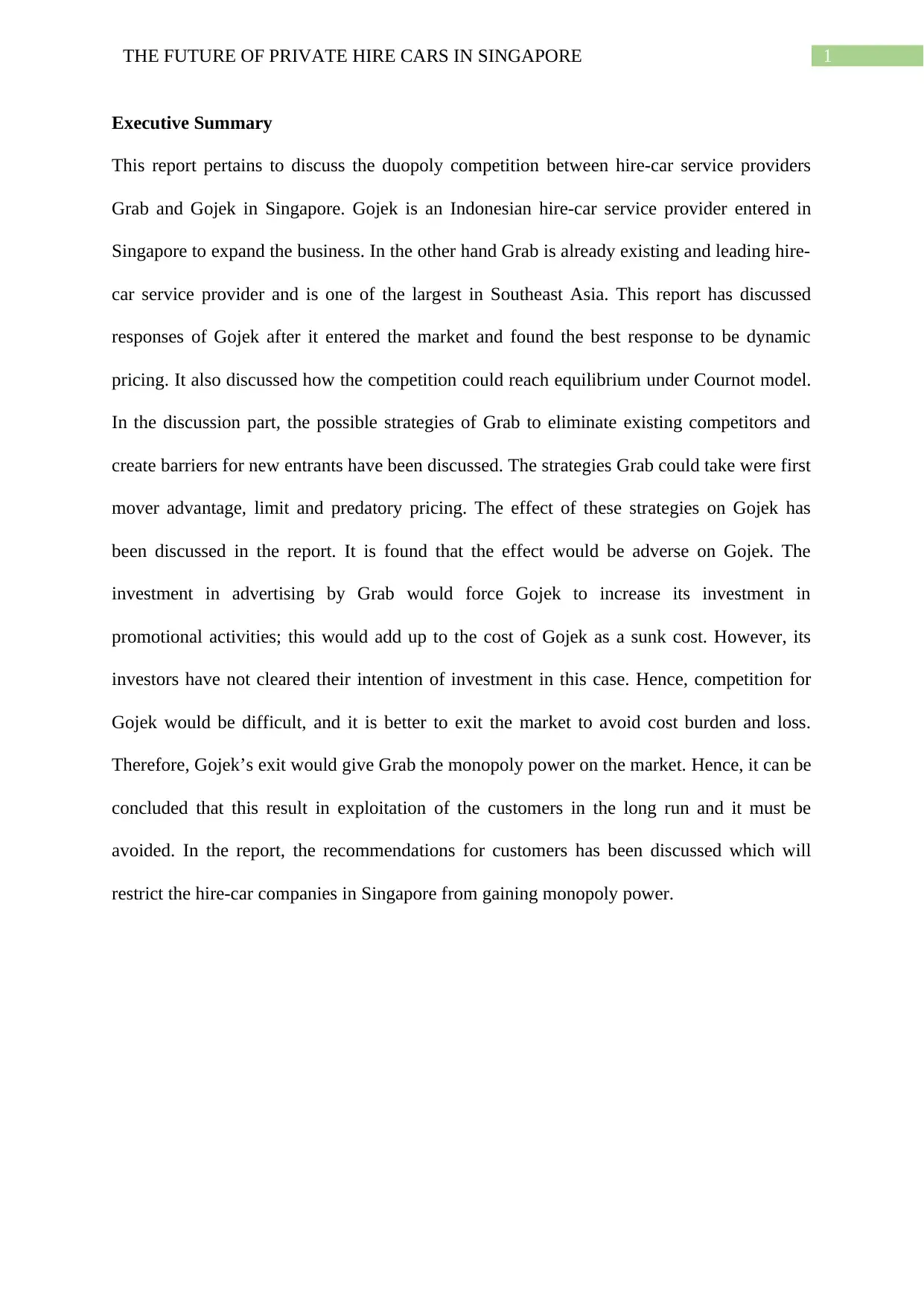
THE FUTURE OF PRIVATE HIRE CARS IN SINGAPORE 1
Executive Summary
This report pertains to discuss the duopoly competition between hire-car service providers
Grab and Gojek in Singapore. Gojek is an Indonesian hire-car service provider entered in
Singapore to expand the business. In the other hand Grab is already existing and leading hire-
car service provider and is one of the largest in Southeast Asia. This report has discussed
responses of Gojek after it entered the market and found the best response to be dynamic
pricing. It also discussed how the competition could reach equilibrium under Cournot model.
In the discussion part, the possible strategies of Grab to eliminate existing competitors and
create barriers for new entrants have been discussed. The strategies Grab could take were first
mover advantage, limit and predatory pricing. The effect of these strategies on Gojek has
been discussed in the report. It is found that the effect would be adverse on Gojek. The
investment in advertising by Grab would force Gojek to increase its investment in
promotional activities; this would add up to the cost of Gojek as a sunk cost. However, its
investors have not cleared their intention of investment in this case. Hence, competition for
Gojek would be difficult, and it is better to exit the market to avoid cost burden and loss.
Therefore, Gojek’s exit would give Grab the monopoly power on the market. Hence, it can be
concluded that this result in exploitation of the customers in the long run and it must be
avoided. In the report, the recommendations for customers has been discussed which will
restrict the hire-car companies in Singapore from gaining monopoly power.
Executive Summary
This report pertains to discuss the duopoly competition between hire-car service providers
Grab and Gojek in Singapore. Gojek is an Indonesian hire-car service provider entered in
Singapore to expand the business. In the other hand Grab is already existing and leading hire-
car service provider and is one of the largest in Southeast Asia. This report has discussed
responses of Gojek after it entered the market and found the best response to be dynamic
pricing. It also discussed how the competition could reach equilibrium under Cournot model.
In the discussion part, the possible strategies of Grab to eliminate existing competitors and
create barriers for new entrants have been discussed. The strategies Grab could take were first
mover advantage, limit and predatory pricing. The effect of these strategies on Gojek has
been discussed in the report. It is found that the effect would be adverse on Gojek. The
investment in advertising by Grab would force Gojek to increase its investment in
promotional activities; this would add up to the cost of Gojek as a sunk cost. However, its
investors have not cleared their intention of investment in this case. Hence, competition for
Gojek would be difficult, and it is better to exit the market to avoid cost burden and loss.
Therefore, Gojek’s exit would give Grab the monopoly power on the market. Hence, it can be
concluded that this result in exploitation of the customers in the long run and it must be
avoided. In the report, the recommendations for customers has been discussed which will
restrict the hire-car companies in Singapore from gaining monopoly power.
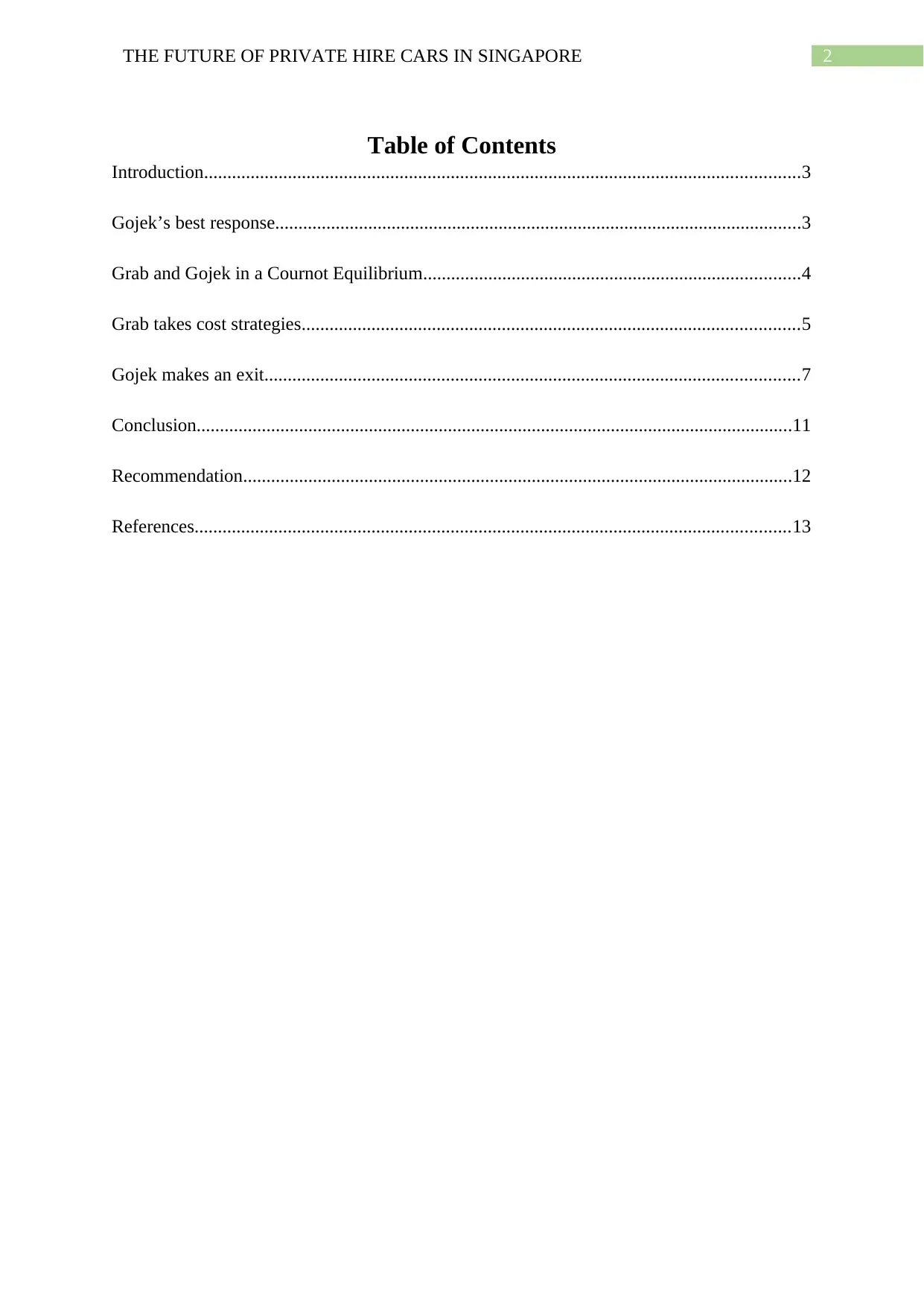
2THE FUTURE OF PRIVATE HIRE CARS IN SINGAPORE
Table of Contents
Introduction................................................................................................................................3
Gojek’s best response.................................................................................................................3
Grab and Gojek in a Cournot Equilibrium.................................................................................4
Grab takes cost strategies...........................................................................................................5
Gojek makes an exit...................................................................................................................7
Conclusion................................................................................................................................11
Recommendation......................................................................................................................12
References................................................................................................................................13
Table of Contents
Introduction................................................................................................................................3
Gojek’s best response.................................................................................................................3
Grab and Gojek in a Cournot Equilibrium.................................................................................4
Grab takes cost strategies...........................................................................................................5
Gojek makes an exit...................................................................................................................7
Conclusion................................................................................................................................11
Recommendation......................................................................................................................12
References................................................................................................................................13
⊘ This is a preview!⊘
Do you want full access?
Subscribe today to unlock all pages.

Trusted by 1+ million students worldwide
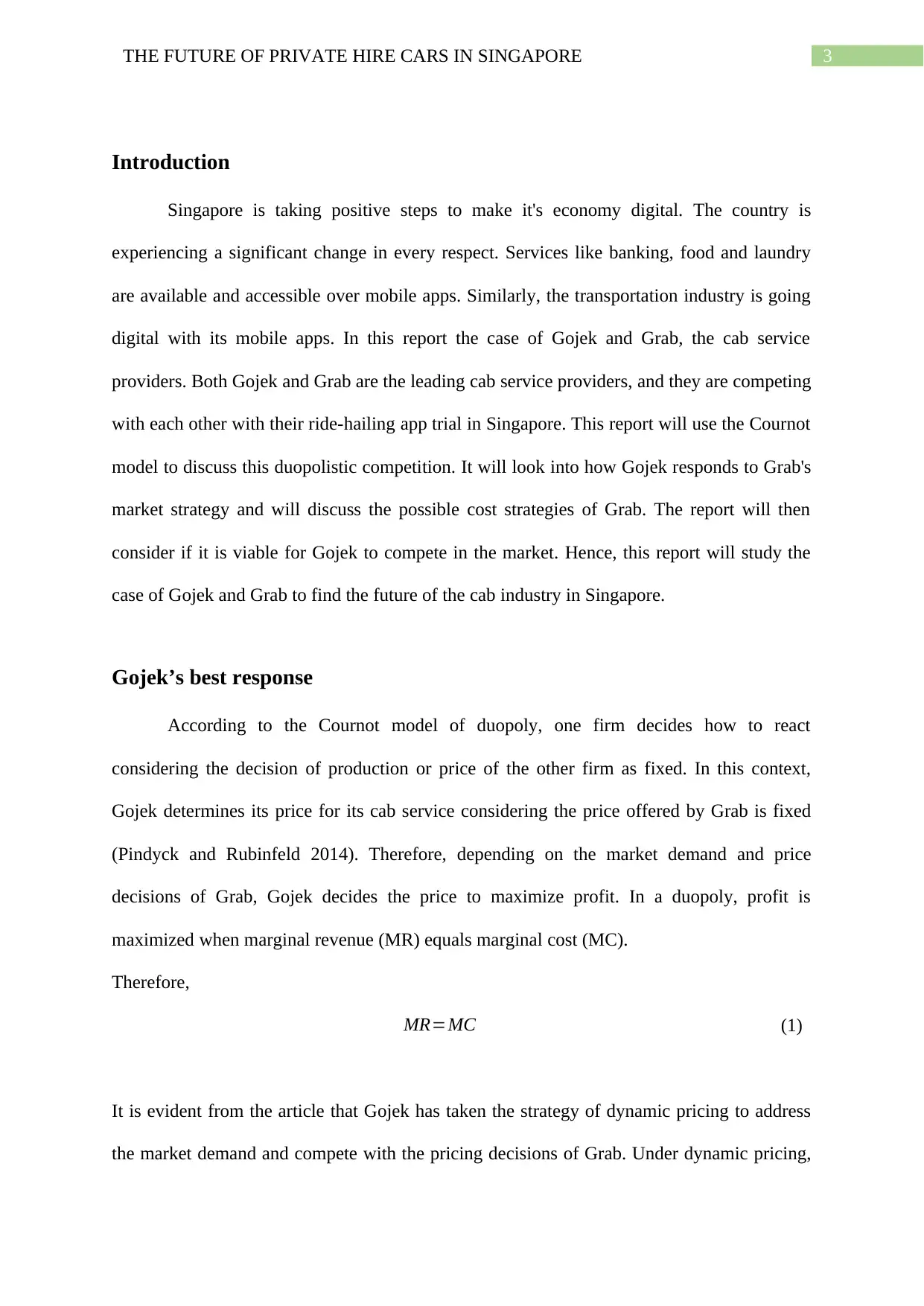
3THE FUTURE OF PRIVATE HIRE CARS IN SINGAPORE
Introduction
Singapore is taking positive steps to make it's economy digital. The country is
experiencing a significant change in every respect. Services like banking, food and laundry
are available and accessible over mobile apps. Similarly, the transportation industry is going
digital with its mobile apps. In this report the case of Gojek and Grab, the cab service
providers. Both Gojek and Grab are the leading cab service providers, and they are competing
with each other with their ride-hailing app trial in Singapore. This report will use the Cournot
model to discuss this duopolistic competition. It will look into how Gojek responds to Grab's
market strategy and will discuss the possible cost strategies of Grab. The report will then
consider if it is viable for Gojek to compete in the market. Hence, this report will study the
case of Gojek and Grab to find the future of the cab industry in Singapore.
Gojek’s best response
According to the Cournot model of duopoly, one firm decides how to react
considering the decision of production or price of the other firm as fixed. In this context,
Gojek determines its price for its cab service considering the price offered by Grab is fixed
(Pindyck and Rubinfeld 2014). Therefore, depending on the market demand and price
decisions of Grab, Gojek decides the price to maximize profit. In a duopoly, profit is
maximized when marginal revenue (MR) equals marginal cost (MC).
Therefore,
MR=MC (1)
It is evident from the article that Gojek has taken the strategy of dynamic pricing to address
the market demand and compete with the pricing decisions of Grab. Under dynamic pricing,
Introduction
Singapore is taking positive steps to make it's economy digital. The country is
experiencing a significant change in every respect. Services like banking, food and laundry
are available and accessible over mobile apps. Similarly, the transportation industry is going
digital with its mobile apps. In this report the case of Gojek and Grab, the cab service
providers. Both Gojek and Grab are the leading cab service providers, and they are competing
with each other with their ride-hailing app trial in Singapore. This report will use the Cournot
model to discuss this duopolistic competition. It will look into how Gojek responds to Grab's
market strategy and will discuss the possible cost strategies of Grab. The report will then
consider if it is viable for Gojek to compete in the market. Hence, this report will study the
case of Gojek and Grab to find the future of the cab industry in Singapore.
Gojek’s best response
According to the Cournot model of duopoly, one firm decides how to react
considering the decision of production or price of the other firm as fixed. In this context,
Gojek determines its price for its cab service considering the price offered by Grab is fixed
(Pindyck and Rubinfeld 2014). Therefore, depending on the market demand and price
decisions of Grab, Gojek decides the price to maximize profit. In a duopoly, profit is
maximized when marginal revenue (MR) equals marginal cost (MC).
Therefore,
MR=MC (1)
It is evident from the article that Gojek has taken the strategy of dynamic pricing to address
the market demand and compete with the pricing decisions of Grab. Under dynamic pricing,
Paraphrase This Document
Need a fresh take? Get an instant paraphrase of this document with our AI Paraphraser
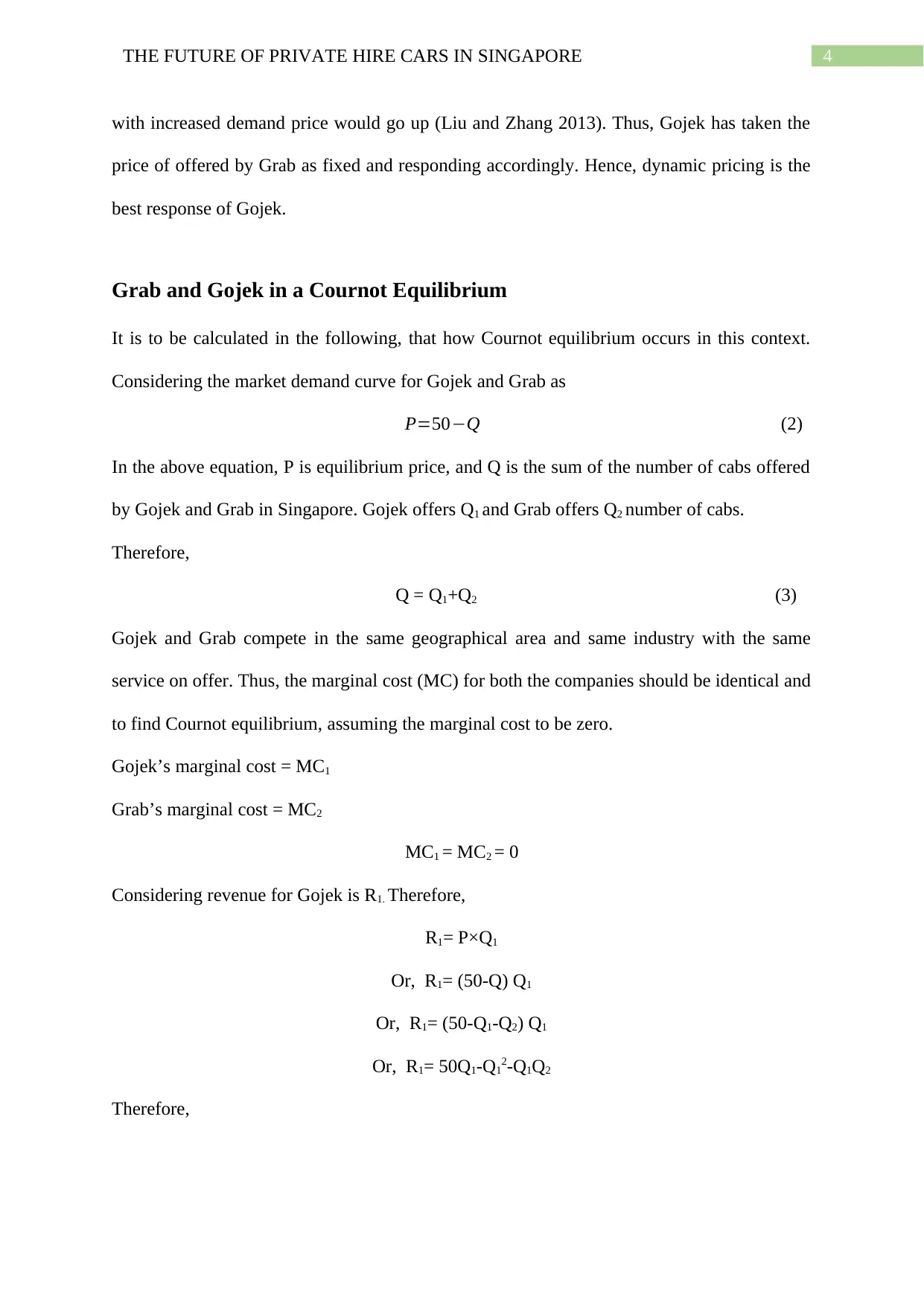
4THE FUTURE OF PRIVATE HIRE CARS IN SINGAPORE
with increased demand price would go up (Liu and Zhang 2013). Thus, Gojek has taken the
price of offered by Grab as fixed and responding accordingly. Hence, dynamic pricing is the
best response of Gojek.
Grab and Gojek in a Cournot Equilibrium
It is to be calculated in the following, that how Cournot equilibrium occurs in this context.
Considering the market demand curve for Gojek and Grab as
P=50−Q (2)
In the above equation, P is equilibrium price, and Q is the sum of the number of cabs offered
by Gojek and Grab in Singapore. Gojek offers Q1 and Grab offers Q2 number of cabs.
Therefore,
Q = Q1+Q2 (3)
Gojek and Grab compete in the same geographical area and same industry with the same
service on offer. Thus, the marginal cost (MC) for both the companies should be identical and
to find Cournot equilibrium, assuming the marginal cost to be zero.
Gojek’s marginal cost = MC1
Grab’s marginal cost = MC2
MC1 = MC2 = 0
Considering revenue for Gojek is R1. Therefore,
R1= P×Q1
Or, R1= (50-Q) Q1
Or, R1= (50-Q1-Q2) Q1
Or, R1= 50Q1-Q12-Q1Q2
Therefore,
with increased demand price would go up (Liu and Zhang 2013). Thus, Gojek has taken the
price of offered by Grab as fixed and responding accordingly. Hence, dynamic pricing is the
best response of Gojek.
Grab and Gojek in a Cournot Equilibrium
It is to be calculated in the following, that how Cournot equilibrium occurs in this context.
Considering the market demand curve for Gojek and Grab as
P=50−Q (2)
In the above equation, P is equilibrium price, and Q is the sum of the number of cabs offered
by Gojek and Grab in Singapore. Gojek offers Q1 and Grab offers Q2 number of cabs.
Therefore,
Q = Q1+Q2 (3)
Gojek and Grab compete in the same geographical area and same industry with the same
service on offer. Thus, the marginal cost (MC) for both the companies should be identical and
to find Cournot equilibrium, assuming the marginal cost to be zero.
Gojek’s marginal cost = MC1
Grab’s marginal cost = MC2
MC1 = MC2 = 0
Considering revenue for Gojek is R1. Therefore,
R1= P×Q1
Or, R1= (50-Q) Q1
Or, R1= (50-Q1-Q2) Q1
Or, R1= 50Q1-Q12-Q1Q2
Therefore,
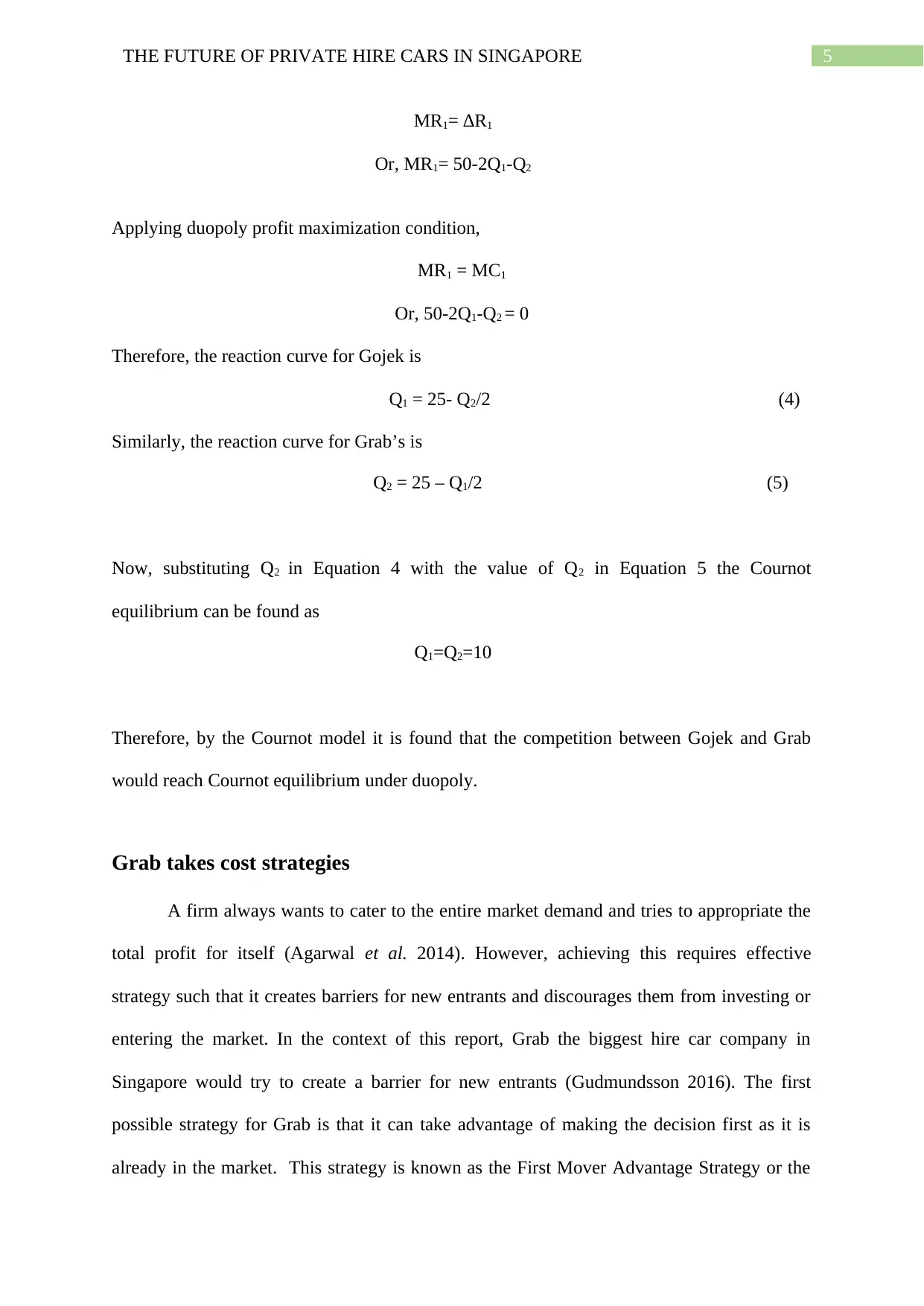
5THE FUTURE OF PRIVATE HIRE CARS IN SINGAPORE
Applying duopoly profit maximization condition,
MR1 = MC1
Or, 50-2Q1-Q2 = 0
Therefore, the reaction curve for Gojek is
Q1 = 25- Q2/2 (4)
Similarly, the reaction curve for Grab’s is
Now, substituting Q2 in Equation 4 with the value of Q2 in Equation 5 the Cournot
equilibrium can be found as
Therefore, by the Cournot model it is found that the competition between Gojek and Grab
would reach Cournot equilibrium under duopoly.
Grab takes cost strategies
A firm always wants to cater to the entire market demand and tries to appropriate the
total profit for itself (Agarwal et al. 2014). However, achieving this requires effective
strategy such that it creates barriers for new entrants and discourages them from investing or
entering the market. In the context of this report, Grab the biggest hire car company in
Singapore would try to create a barrier for new entrants (Gudmundsson 2016). The first
possible strategy for Grab is that it can take advantage of making the decision first as it is
already in the market. This strategy is known as the First Mover Advantage Strategy or the
MR1= ∆R1
Or, MR1= 50-2Q1-Q2
Q2 = 25 – Q1/2 (5)
Q1=Q2=10
Applying duopoly profit maximization condition,
MR1 = MC1
Or, 50-2Q1-Q2 = 0
Therefore, the reaction curve for Gojek is
Q1 = 25- Q2/2 (4)
Similarly, the reaction curve for Grab’s is
Now, substituting Q2 in Equation 4 with the value of Q2 in Equation 5 the Cournot
equilibrium can be found as
Therefore, by the Cournot model it is found that the competition between Gojek and Grab
would reach Cournot equilibrium under duopoly.
Grab takes cost strategies
A firm always wants to cater to the entire market demand and tries to appropriate the
total profit for itself (Agarwal et al. 2014). However, achieving this requires effective
strategy such that it creates barriers for new entrants and discourages them from investing or
entering the market. In the context of this report, Grab the biggest hire car company in
Singapore would try to create a barrier for new entrants (Gudmundsson 2016). The first
possible strategy for Grab is that it can take advantage of making the decision first as it is
already in the market. This strategy is known as the First Mover Advantage Strategy or the
MR1= ∆R1
Or, MR1= 50-2Q1-Q2
Q2 = 25 – Q1/2 (5)
Q1=Q2=10
⊘ This is a preview!⊘
Do you want full access?
Subscribe today to unlock all pages.

Trusted by 1+ million students worldwide
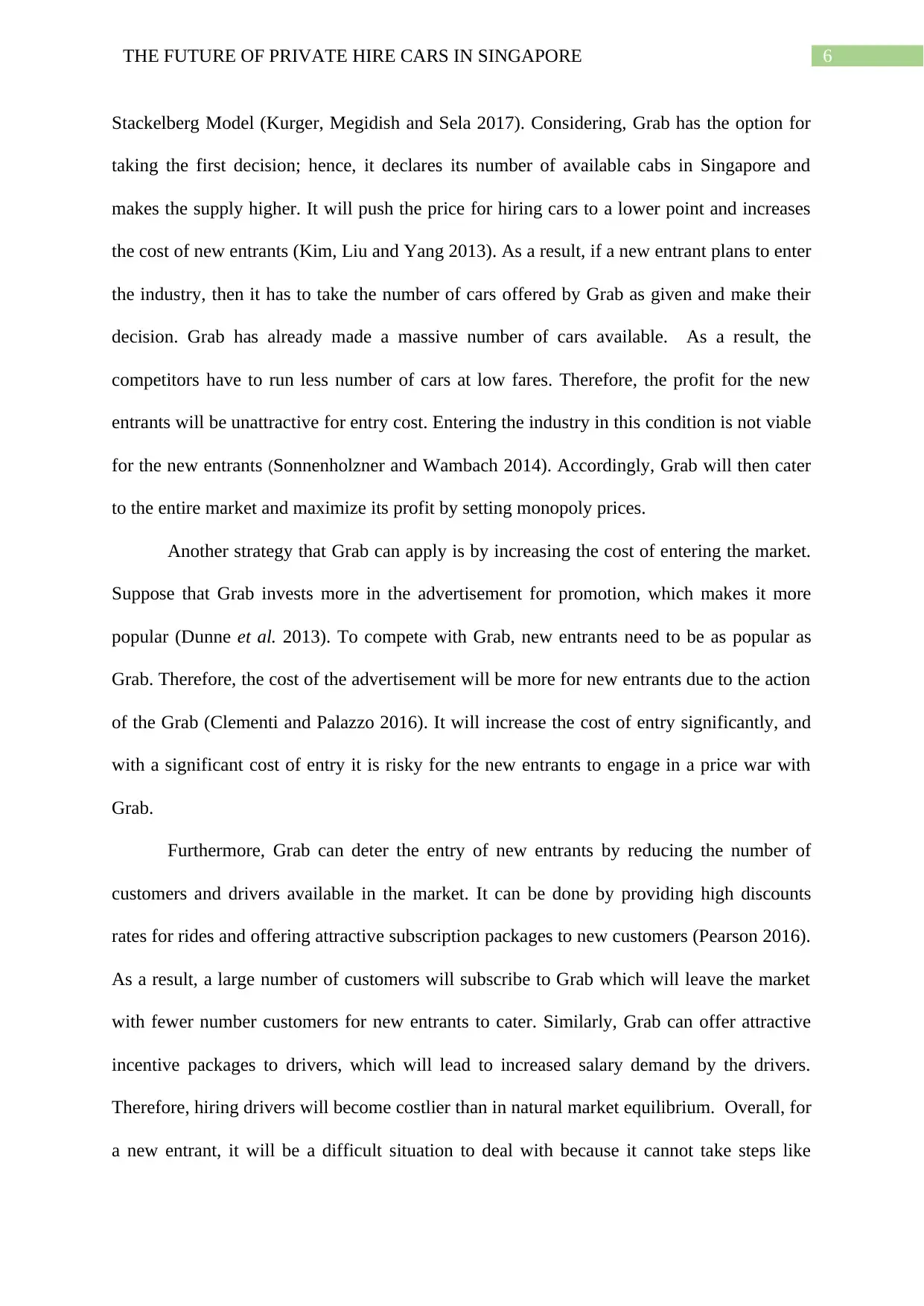
6THE FUTURE OF PRIVATE HIRE CARS IN SINGAPORE
Stackelberg Model (Kurger, Megidish and Sela 2017). Considering, Grab has the option for
taking the first decision; hence, it declares its number of available cabs in Singapore and
makes the supply higher. It will push the price for hiring cars to a lower point and increases
the cost of new entrants (Kim, Liu and Yang 2013). As a result, if a new entrant plans to enter
the industry, then it has to take the number of cars offered by Grab as given and make their
decision. Grab has already made a massive number of cars available. As a result, the
competitors have to run less number of cars at low fares. Therefore, the profit for the new
entrants will be unattractive for entry cost. Entering the industry in this condition is not viable
for the new entrants (Sonnenholzner and Wambach 2014). Accordingly, Grab will then cater
to the entire market and maximize its profit by setting monopoly prices.
Another strategy that Grab can apply is by increasing the cost of entering the market.
Suppose that Grab invests more in the advertisement for promotion, which makes it more
popular (Dunne et al. 2013). To compete with Grab, new entrants need to be as popular as
Grab. Therefore, the cost of the advertisement will be more for new entrants due to the action
of the Grab (Clementi and Palazzo 2016). It will increase the cost of entry significantly, and
with a significant cost of entry it is risky for the new entrants to engage in a price war with
Grab.
Furthermore, Grab can deter the entry of new entrants by reducing the number of
customers and drivers available in the market. It can be done by providing high discounts
rates for rides and offering attractive subscription packages to new customers (Pearson 2016).
As a result, a large number of customers will subscribe to Grab which will leave the market
with fewer number customers for new entrants to cater. Similarly, Grab can offer attractive
incentive packages to drivers, which will lead to increased salary demand by the drivers.
Therefore, hiring drivers will become costlier than in natural market equilibrium. Overall, for
a new entrant, it will be a difficult situation to deal with because it cannot take steps like
Stackelberg Model (Kurger, Megidish and Sela 2017). Considering, Grab has the option for
taking the first decision; hence, it declares its number of available cabs in Singapore and
makes the supply higher. It will push the price for hiring cars to a lower point and increases
the cost of new entrants (Kim, Liu and Yang 2013). As a result, if a new entrant plans to enter
the industry, then it has to take the number of cars offered by Grab as given and make their
decision. Grab has already made a massive number of cars available. As a result, the
competitors have to run less number of cars at low fares. Therefore, the profit for the new
entrants will be unattractive for entry cost. Entering the industry in this condition is not viable
for the new entrants (Sonnenholzner and Wambach 2014). Accordingly, Grab will then cater
to the entire market and maximize its profit by setting monopoly prices.
Another strategy that Grab can apply is by increasing the cost of entering the market.
Suppose that Grab invests more in the advertisement for promotion, which makes it more
popular (Dunne et al. 2013). To compete with Grab, new entrants need to be as popular as
Grab. Therefore, the cost of the advertisement will be more for new entrants due to the action
of the Grab (Clementi and Palazzo 2016). It will increase the cost of entry significantly, and
with a significant cost of entry it is risky for the new entrants to engage in a price war with
Grab.
Furthermore, Grab can deter the entry of new entrants by reducing the number of
customers and drivers available in the market. It can be done by providing high discounts
rates for rides and offering attractive subscription packages to new customers (Pearson 2016).
As a result, a large number of customers will subscribe to Grab which will leave the market
with fewer number customers for new entrants to cater. Similarly, Grab can offer attractive
incentive packages to drivers, which will lead to increased salary demand by the drivers.
Therefore, hiring drivers will become costlier than in natural market equilibrium. Overall, for
a new entrant, it will be a difficult situation to deal with because it cannot take steps like
Paraphrase This Document
Need a fresh take? Get an instant paraphrase of this document with our AI Paraphraser
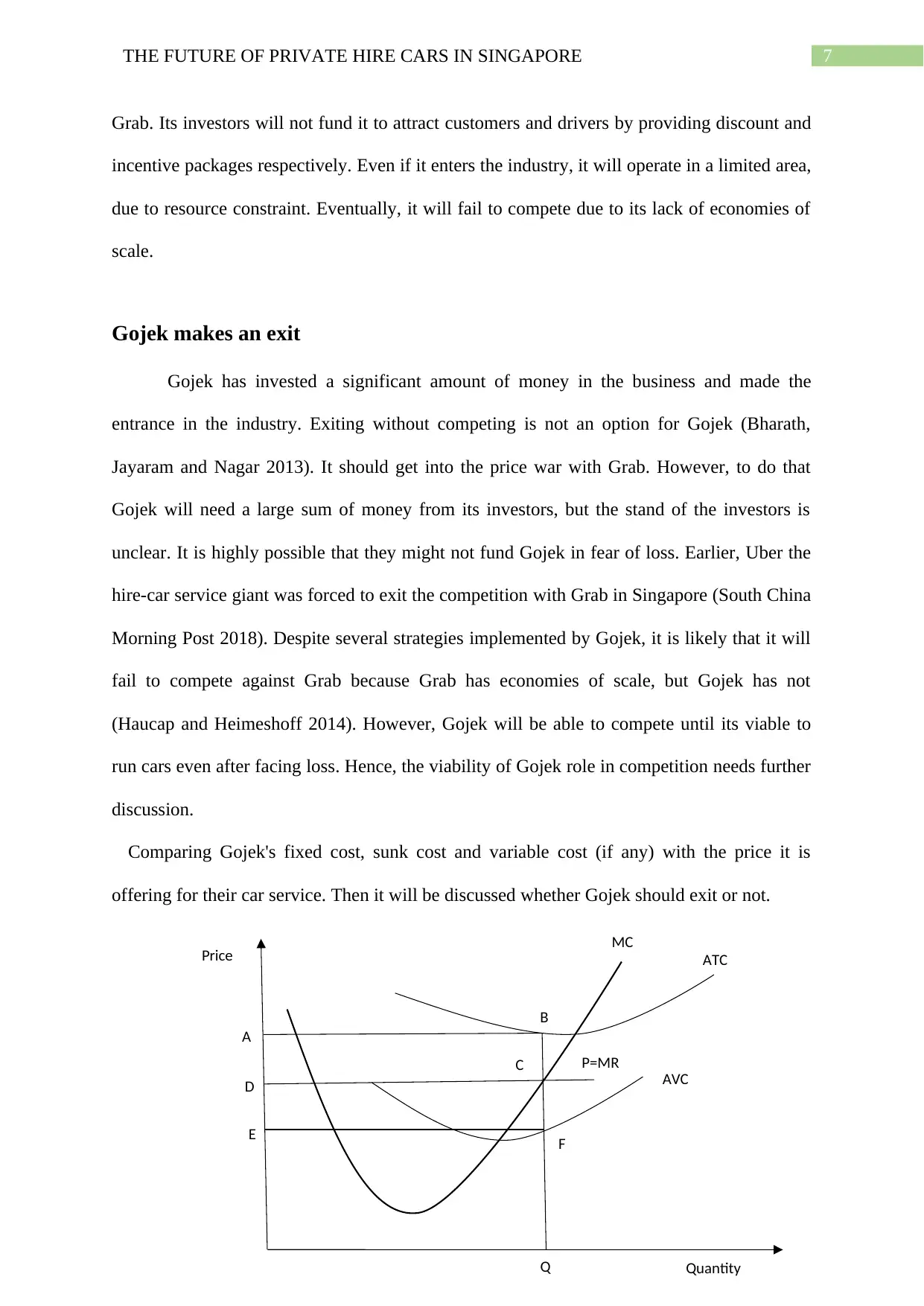
7THE FUTURE OF PRIVATE HIRE CARS IN SINGAPORE
Grab. Its investors will not fund it to attract customers and drivers by providing discount and
incentive packages respectively. Even if it enters the industry, it will operate in a limited area,
due to resource constraint. Eventually, it will fail to compete due to its lack of economies of
scale.
Gojek makes an exit
Gojek has invested a significant amount of money in the business and made the
entrance in the industry. Exiting without competing is not an option for Gojek (Bharath,
Jayaram and Nagar 2013). It should get into the price war with Grab. However, to do that
Gojek will need a large sum of money from its investors, but the stand of the investors is
unclear. It is highly possible that they might not fund Gojek in fear of loss. Earlier, Uber the
hire-car service giant was forced to exit the competition with Grab in Singapore (South China
Morning Post 2018). Despite several strategies implemented by Gojek, it is likely that it will
fail to compete against Grab because Grab has economies of scale, but Gojek has not
(Haucap and Heimeshoff 2014). However, Gojek will be able to compete until its viable to
run cars even after facing loss. Hence, the viability of Gojek role in competition needs further
discussion.
Comparing Gojek's fixed cost, sunk cost and variable cost (if any) with the price it is
offering for their car service. Then it will be discussed whether Gojek should exit or not.
A
D
E F
MC
ATC
AVC
P=MR
B
C
Price
QuantityQ
Grab. Its investors will not fund it to attract customers and drivers by providing discount and
incentive packages respectively. Even if it enters the industry, it will operate in a limited area,
due to resource constraint. Eventually, it will fail to compete due to its lack of economies of
scale.
Gojek makes an exit
Gojek has invested a significant amount of money in the business and made the
entrance in the industry. Exiting without competing is not an option for Gojek (Bharath,
Jayaram and Nagar 2013). It should get into the price war with Grab. However, to do that
Gojek will need a large sum of money from its investors, but the stand of the investors is
unclear. It is highly possible that they might not fund Gojek in fear of loss. Earlier, Uber the
hire-car service giant was forced to exit the competition with Grab in Singapore (South China
Morning Post 2018). Despite several strategies implemented by Gojek, it is likely that it will
fail to compete against Grab because Grab has economies of scale, but Gojek has not
(Haucap and Heimeshoff 2014). However, Gojek will be able to compete until its viable to
run cars even after facing loss. Hence, the viability of Gojek role in competition needs further
discussion.
Comparing Gojek's fixed cost, sunk cost and variable cost (if any) with the price it is
offering for their car service. Then it will be discussed whether Gojek should exit or not.
A
D
E F
MC
ATC
AVC
P=MR
B
C
Price
QuantityQ
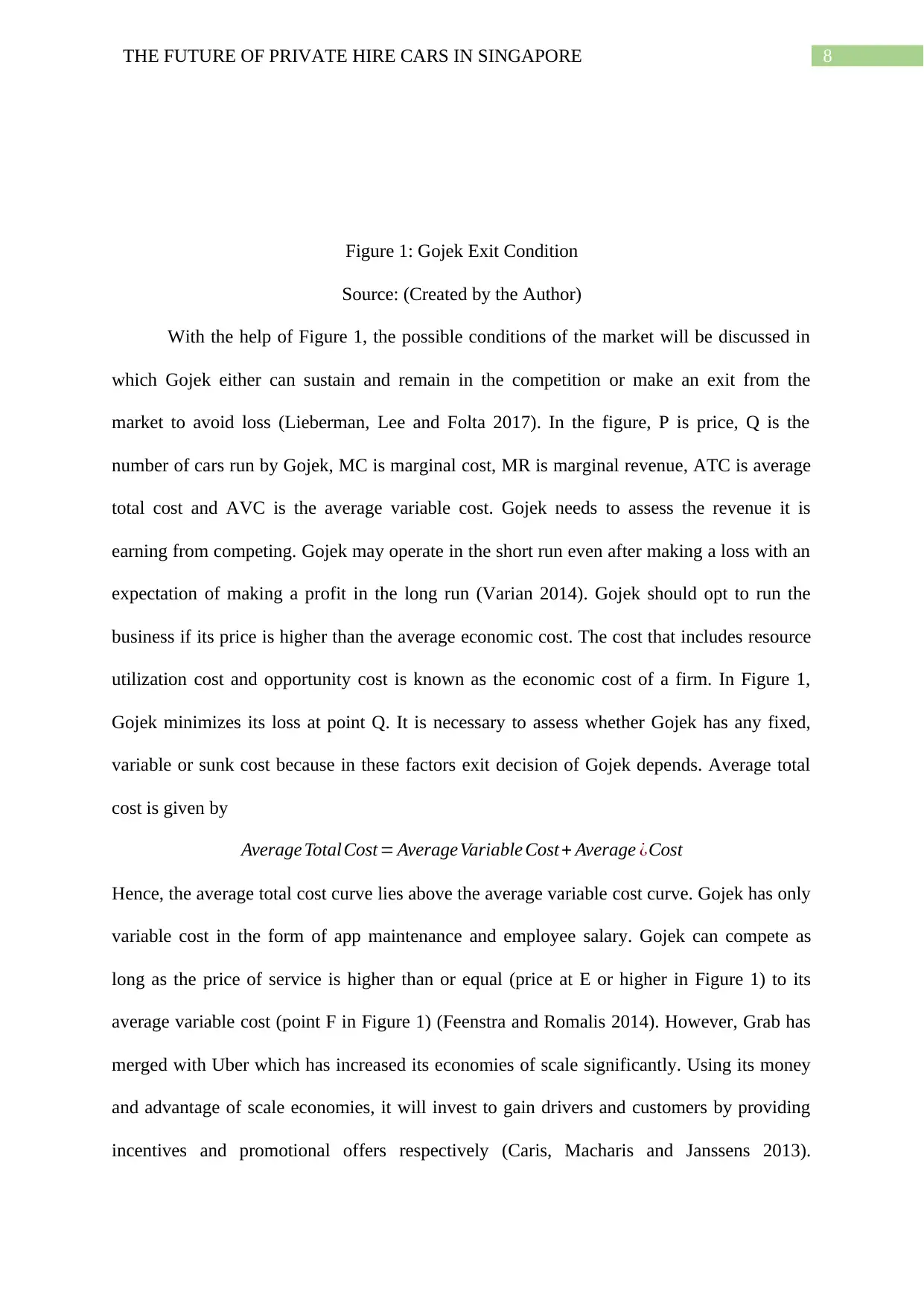
8THE FUTURE OF PRIVATE HIRE CARS IN SINGAPORE
Figure 1: Gojek Exit Condition
Source: (Created by the Author)
With the help of Figure 1, the possible conditions of the market will be discussed in
which Gojek either can sustain and remain in the competition or make an exit from the
market to avoid loss (Lieberman, Lee and Folta 2017). In the figure, P is price, Q is the
number of cars run by Gojek, MC is marginal cost, MR is marginal revenue, ATC is average
total cost and AVC is the average variable cost. Gojek needs to assess the revenue it is
earning from competing. Gojek may operate in the short run even after making a loss with an
expectation of making a profit in the long run (Varian 2014). Gojek should opt to run the
business if its price is higher than the average economic cost. The cost that includes resource
utilization cost and opportunity cost is known as the economic cost of a firm. In Figure 1,
Gojek minimizes its loss at point Q. It is necessary to assess whether Gojek has any fixed,
variable or sunk cost because in these factors exit decision of Gojek depends. Average total
cost is given by
Average Total Cost = Average Variable Cost + Average ¿Cost
Hence, the average total cost curve lies above the average variable cost curve. Gojek has only
variable cost in the form of app maintenance and employee salary. Gojek can compete as
long as the price of service is higher than or equal (price at E or higher in Figure 1) to its
average variable cost (point F in Figure 1) (Feenstra and Romalis 2014). However, Grab has
merged with Uber which has increased its economies of scale significantly. Using its money
and advantage of scale economies, it will invest to gain drivers and customers by providing
incentives and promotional offers respectively (Caris, Macharis and Janssens 2013).
Figure 1: Gojek Exit Condition
Source: (Created by the Author)
With the help of Figure 1, the possible conditions of the market will be discussed in
which Gojek either can sustain and remain in the competition or make an exit from the
market to avoid loss (Lieberman, Lee and Folta 2017). In the figure, P is price, Q is the
number of cars run by Gojek, MC is marginal cost, MR is marginal revenue, ATC is average
total cost and AVC is the average variable cost. Gojek needs to assess the revenue it is
earning from competing. Gojek may operate in the short run even after making a loss with an
expectation of making a profit in the long run (Varian 2014). Gojek should opt to run the
business if its price is higher than the average economic cost. The cost that includes resource
utilization cost and opportunity cost is known as the economic cost of a firm. In Figure 1,
Gojek minimizes its loss at point Q. It is necessary to assess whether Gojek has any fixed,
variable or sunk cost because in these factors exit decision of Gojek depends. Average total
cost is given by
Average Total Cost = Average Variable Cost + Average ¿Cost
Hence, the average total cost curve lies above the average variable cost curve. Gojek has only
variable cost in the form of app maintenance and employee salary. Gojek can compete as
long as the price of service is higher than or equal (price at E or higher in Figure 1) to its
average variable cost (point F in Figure 1) (Feenstra and Romalis 2014). However, Grab has
merged with Uber which has increased its economies of scale significantly. Using its money
and advantage of scale economies, it will invest to gain drivers and customers by providing
incentives and promotional offers respectively (Caris, Macharis and Janssens 2013).
⊘ This is a preview!⊘
Do you want full access?
Subscribe today to unlock all pages.

Trusted by 1+ million students worldwide
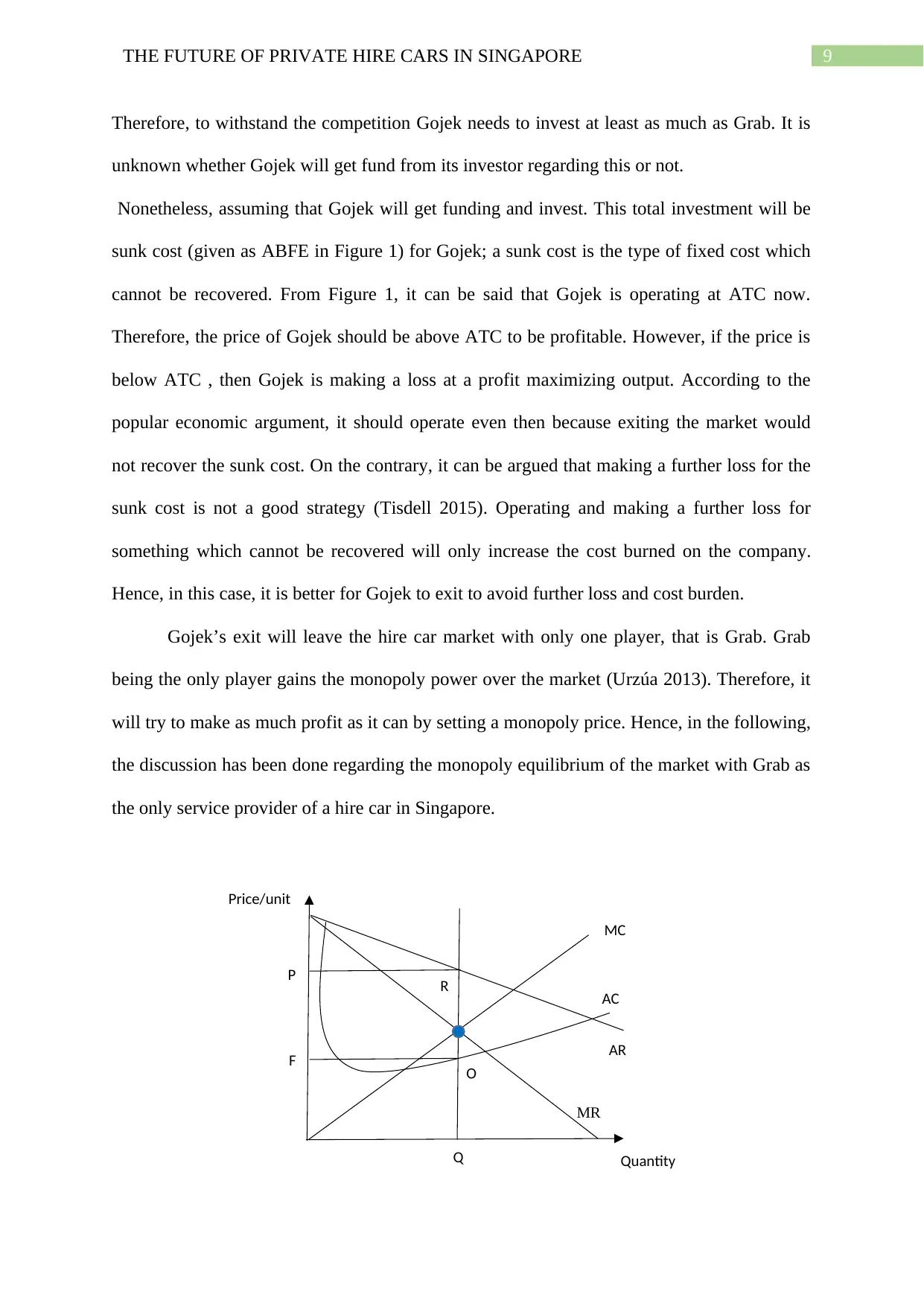
9THE FUTURE OF PRIVATE HIRE CARS IN SINGAPORE
Therefore, to withstand the competition Gojek needs to invest at least as much as Grab. It is
unknown whether Gojek will get fund from its investor regarding this or not.
Nonetheless, assuming that Gojek will get funding and invest. This total investment will be
sunk cost (given as ABFE in Figure 1) for Gojek; a sunk cost is the type of fixed cost which
cannot be recovered. From Figure 1, it can be said that Gojek is operating at ATC now.
Therefore, the price of Gojek should be above ATC to be profitable. However, if the price is
below ATC , then Gojek is making a loss at a profit maximizing output. According to the
popular economic argument, it should operate even then because exiting the market would
not recover the sunk cost. On the contrary, it can be argued that making a further loss for the
sunk cost is not a good strategy (Tisdell 2015). Operating and making a further loss for
something which cannot be recovered will only increase the cost burned on the company.
Hence, in this case, it is better for Gojek to exit to avoid further loss and cost burden.
Gojek’s exit will leave the hire car market with only one player, that is Grab. Grab
being the only player gains the monopoly power over the market (Urzúa 2013). Therefore, it
will try to make as much profit as it can by setting a monopoly price. Hence, in the following,
the discussion has been done regarding the monopoly equilibrium of the market with Grab as
the only service provider of a hire car in Singapore.
MR
AC
R
Price/unit
Q Quantity
AR
MC
O
P
F
Therefore, to withstand the competition Gojek needs to invest at least as much as Grab. It is
unknown whether Gojek will get fund from its investor regarding this or not.
Nonetheless, assuming that Gojek will get funding and invest. This total investment will be
sunk cost (given as ABFE in Figure 1) for Gojek; a sunk cost is the type of fixed cost which
cannot be recovered. From Figure 1, it can be said that Gojek is operating at ATC now.
Therefore, the price of Gojek should be above ATC to be profitable. However, if the price is
below ATC , then Gojek is making a loss at a profit maximizing output. According to the
popular economic argument, it should operate even then because exiting the market would
not recover the sunk cost. On the contrary, it can be argued that making a further loss for the
sunk cost is not a good strategy (Tisdell 2015). Operating and making a further loss for
something which cannot be recovered will only increase the cost burned on the company.
Hence, in this case, it is better for Gojek to exit to avoid further loss and cost burden.
Gojek’s exit will leave the hire car market with only one player, that is Grab. Grab
being the only player gains the monopoly power over the market (Urzúa 2013). Therefore, it
will try to make as much profit as it can by setting a monopoly price. Hence, in the following,
the discussion has been done regarding the monopoly equilibrium of the market with Grab as
the only service provider of a hire car in Singapore.
MR
AC
R
Price/unit
Q Quantity
AR
MC
O
P
F
Paraphrase This Document
Need a fresh take? Get an instant paraphrase of this document with our AI Paraphraser
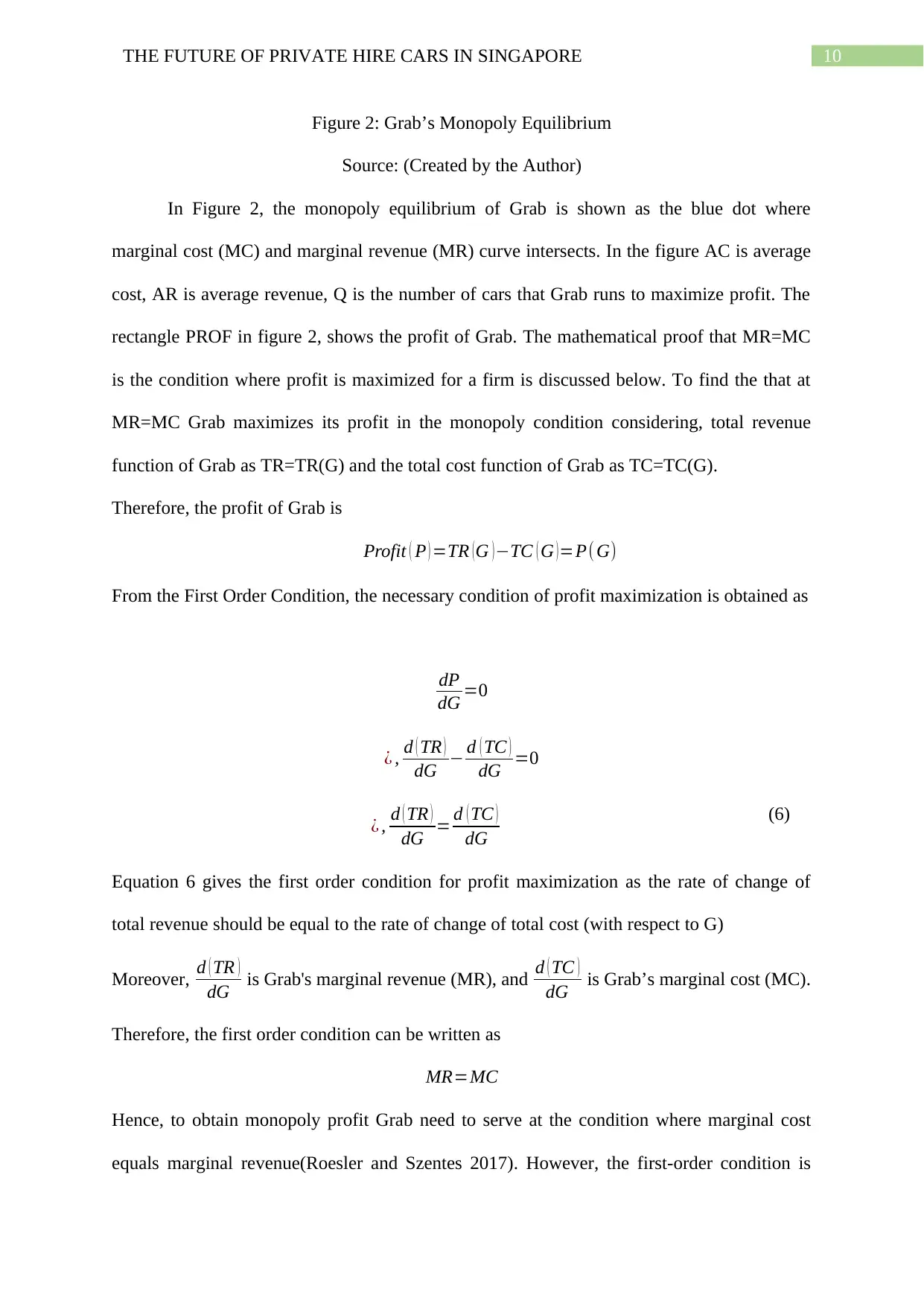
10THE FUTURE OF PRIVATE HIRE CARS IN SINGAPORE
Figure 2: Grab’s Monopoly Equilibrium
Source: (Created by the Author)
In Figure 2, the monopoly equilibrium of Grab is shown as the blue dot where
marginal cost (MC) and marginal revenue (MR) curve intersects. In the figure AC is average
cost, AR is average revenue, Q is the number of cars that Grab runs to maximize profit. The
rectangle PROF in figure 2, shows the profit of Grab. The mathematical proof that MR=MC
is the condition where profit is maximized for a firm is discussed below. To find the that at
MR=MC Grab maximizes its profit in the monopoly condition considering, total revenue
function of Grab as TR=TR(G) and the total cost function of Grab as TC=TC(G).
Therefore, the profit of Grab is
Profit ( P ) =TR ( G ) −TC ( G ) =P(G)
From the First Order Condition, the necessary condition of profit maximization is obtained as
dP
dG =0
¿ , d ( TR )
dG − d ( TC )
dG =0
¿ , d ( TR )
dG = d ( TC )
dG
(6)
Equation 6 gives the first order condition for profit maximization as the rate of change of
total revenue should be equal to the rate of change of total cost (with respect to G)
Moreover, d ( TR )
dG is Grab's marginal revenue (MR), and d ( TC )
dG is Grab’s marginal cost (MC).
Therefore, the first order condition can be written as
MR=MC
Hence, to obtain monopoly profit Grab need to serve at the condition where marginal cost
equals marginal revenue(Roesler and Szentes 2017). However, the first-order condition is
Figure 2: Grab’s Monopoly Equilibrium
Source: (Created by the Author)
In Figure 2, the monopoly equilibrium of Grab is shown as the blue dot where
marginal cost (MC) and marginal revenue (MR) curve intersects. In the figure AC is average
cost, AR is average revenue, Q is the number of cars that Grab runs to maximize profit. The
rectangle PROF in figure 2, shows the profit of Grab. The mathematical proof that MR=MC
is the condition where profit is maximized for a firm is discussed below. To find the that at
MR=MC Grab maximizes its profit in the monopoly condition considering, total revenue
function of Grab as TR=TR(G) and the total cost function of Grab as TC=TC(G).
Therefore, the profit of Grab is
Profit ( P ) =TR ( G ) −TC ( G ) =P(G)
From the First Order Condition, the necessary condition of profit maximization is obtained as
dP
dG =0
¿ , d ( TR )
dG − d ( TC )
dG =0
¿ , d ( TR )
dG = d ( TC )
dG
(6)
Equation 6 gives the first order condition for profit maximization as the rate of change of
total revenue should be equal to the rate of change of total cost (with respect to G)
Moreover, d ( TR )
dG is Grab's marginal revenue (MR), and d ( TC )
dG is Grab’s marginal cost (MC).
Therefore, the first order condition can be written as
MR=MC
Hence, to obtain monopoly profit Grab need to serve at the condition where marginal cost
equals marginal revenue(Roesler and Szentes 2017). However, the first-order condition is
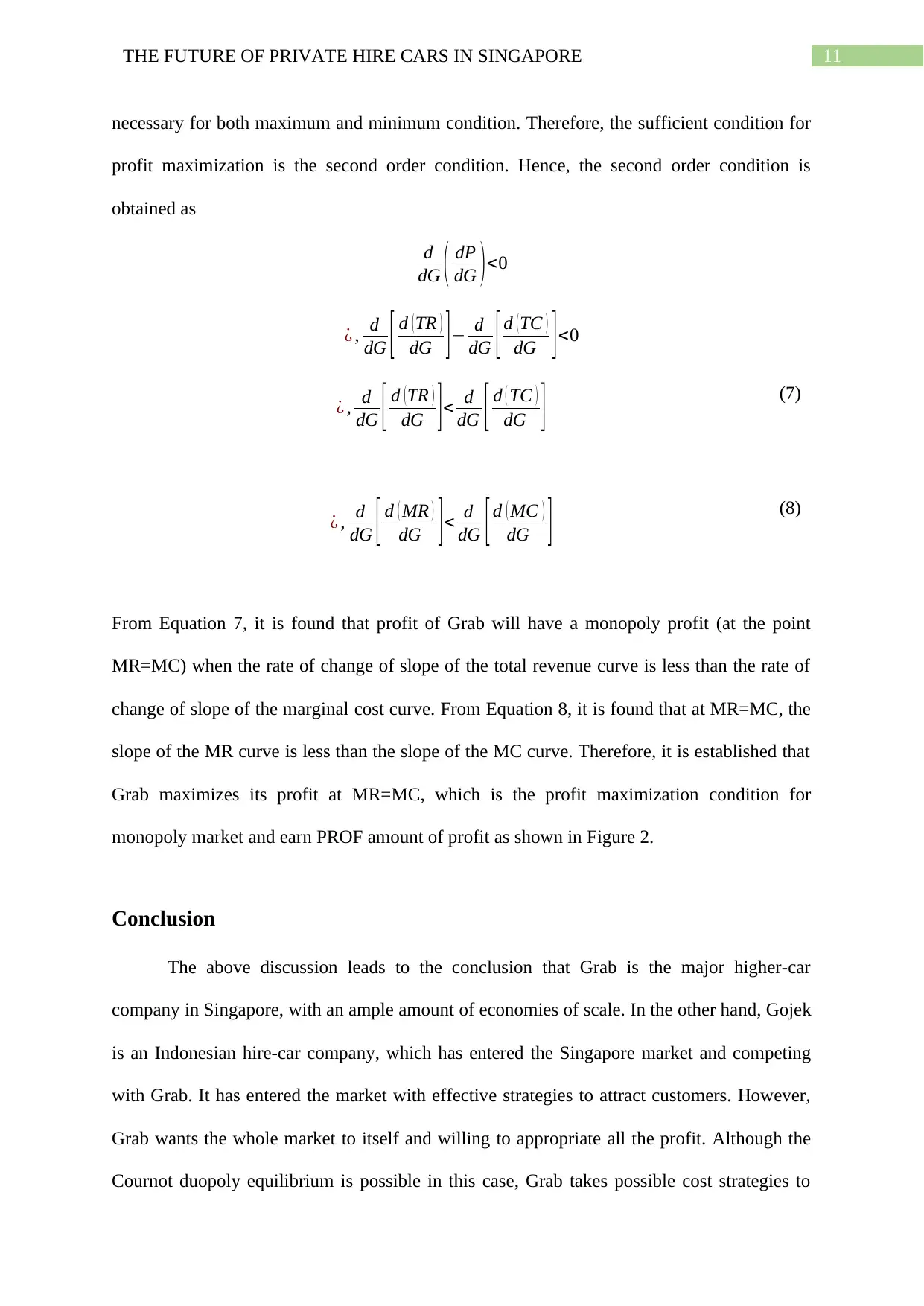
11THE FUTURE OF PRIVATE HIRE CARS IN SINGAPORE
necessary for both maximum and minimum condition. Therefore, the sufficient condition for
profit maximization is the second order condition. Hence, the second order condition is
obtained as
d
dG ( dP
dG )<0
¿ , d
dG [ d ( TR )
dG ] − d
dG [ d ( TC )
dG ] <0
¿ , d
dG [ d (TR )
dG ]< d
dG [ d ( TC )
dG ] (7)
¿ , d
dG [ d ( MR )
dG ]< d
dG [ d ( MC )
dG ] (8)
From Equation 7, it is found that profit of Grab will have a monopoly profit (at the point
MR=MC) when the rate of change of slope of the total revenue curve is less than the rate of
change of slope of the marginal cost curve. From Equation 8, it is found that at MR=MC, the
slope of the MR curve is less than the slope of the MC curve. Therefore, it is established that
Grab maximizes its profit at MR=MC, which is the profit maximization condition for
monopoly market and earn PROF amount of profit as shown in Figure 2.
Conclusion
The above discussion leads to the conclusion that Grab is the major higher-car
company in Singapore, with an ample amount of economies of scale. In the other hand, Gojek
is an Indonesian hire-car company, which has entered the Singapore market and competing
with Grab. It has entered the market with effective strategies to attract customers. However,
Grab wants the whole market to itself and willing to appropriate all the profit. Although the
Cournot duopoly equilibrium is possible in this case, Grab takes possible cost strategies to
necessary for both maximum and minimum condition. Therefore, the sufficient condition for
profit maximization is the second order condition. Hence, the second order condition is
obtained as
d
dG ( dP
dG )<0
¿ , d
dG [ d ( TR )
dG ] − d
dG [ d ( TC )
dG ] <0
¿ , d
dG [ d (TR )
dG ]< d
dG [ d ( TC )
dG ] (7)
¿ , d
dG [ d ( MR )
dG ]< d
dG [ d ( MC )
dG ] (8)
From Equation 7, it is found that profit of Grab will have a monopoly profit (at the point
MR=MC) when the rate of change of slope of the total revenue curve is less than the rate of
change of slope of the marginal cost curve. From Equation 8, it is found that at MR=MC, the
slope of the MR curve is less than the slope of the MC curve. Therefore, it is established that
Grab maximizes its profit at MR=MC, which is the profit maximization condition for
monopoly market and earn PROF amount of profit as shown in Figure 2.
Conclusion
The above discussion leads to the conclusion that Grab is the major higher-car
company in Singapore, with an ample amount of economies of scale. In the other hand, Gojek
is an Indonesian hire-car company, which has entered the Singapore market and competing
with Grab. It has entered the market with effective strategies to attract customers. However,
Grab wants the whole market to itself and willing to appropriate all the profit. Although the
Cournot duopoly equilibrium is possible in this case, Grab takes possible cost strategies to
⊘ This is a preview!⊘
Do you want full access?
Subscribe today to unlock all pages.

Trusted by 1+ million students worldwide
1 out of 16
Related Documents
Your All-in-One AI-Powered Toolkit for Academic Success.
+13062052269
info@desklib.com
Available 24*7 on WhatsApp / Email
![[object Object]](/_next/static/media/star-bottom.7253800d.svg)
Unlock your academic potential
Copyright © 2020–2025 A2Z Services. All Rights Reserved. Developed and managed by ZUCOL.





